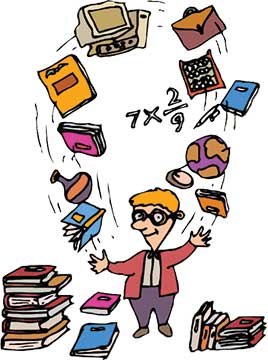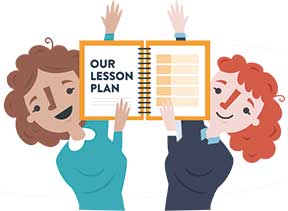P. Ajitha
The school is a community of learners where both the teachers and the taught are continually engaged in the teaching-learning process. The rate and extent of learning is either accelerated or impeded by one crucial factor in this equation, namely the vibrancy of interaction between the teacher and the student. The actual learning outcome, discernible not just from standardized testing, but from the radiant faces of children discovering first-hand the joy of learning something new that fosters better understanding of the world around them, would be the touchstone of learning standards in an ideal world.
For such a scenario to become an everyday reality, educators must strive to create a vibrant learning space which allows room for creativity, constant experimentation and most importantly, autonomy for the teacher for the objectives of education to be realized.
It is true that some are born to be teachers and they indeed are a rarity. But it is equally true that the right mix of talent, skills and training can create good teachers. But more often than not, such teachers lose their drive and the fire that initially drew them to the profession. Their productivity hits a saturation point, their enthusiasm deflated – experiencing a burnout! It is precisely to prevent this from occurring that educational institutions must garner their resources to address the root causes of the dismal situation in order to keep the community of teachers energized. And to ensure that teachers are able to channelize their creative energies into the teaching-learning process, they must feel and become empowered.
How can institutions accomplish this?
Let’s look into some deceivingly innocuous measures that can be taken which can lift the spirits of teachers and give them the much needed boost and the ever elusive satisfaction:
 Reducing non-academic workload
Reducing non-academic workload
A teacher is a multi-tasker, no doubt! Her ability to fulfil the requirements of multiple roles is something that comes with the territory. Juggling between these responsibilities – lesson planning, teaching, conducting assessments, valuating test papers in addition to the regular correction of exercise books and home assignments, paper setting, conducting activities/events, documenting evidence of assessment, result preparation…… the list seems endless! (and these are just the basic responsibilities). As if these are not enough, teachers are burdened with non-academic work that saps into their energy reserves which they ought to conserve to carry out their core responsibilities. A teacher already has enough academic work on her plate which requires patience and perseverance to accomplish. And to add to her woes, more and more non-academic work is thrust on her which hampers the overall productivity and kills the enthusiasm (if there is any left!) Those at the helm of running such portals of learning should free the teacher of work that can easily be delegated to other staff so that the teachers are able to do what they are actually required to do with unhampered zeal and vigour!
Greater autonomy
Too much of centralized, hierarchical and top-down power structure observed in policy framing and decision-making process on academic matters stifles the free-spirited and tames the otherwise feisty spirited teachers. With a little flexibility in designing, implementing and decision-making process, teachers will be able to work towards realizing their objectives with more involvement than in a scenario where they feel that they do not have any say in important processes and are merely meant to follow what should and should not be done within the confines of their classroom.
 Becoming reflective teaching practitioners
Becoming reflective teaching practitioners
At the start of every academic session, learning objectives in all subject domains/disciplines are defined and a road map charting significant milestones are identified and a plan of action implemented through the course of the year keeping in mind the current levels of attainment of students as pitted against what they are expected to achieve. A teacher is the best judge to ascertain whether the academic activities/exercises are serving the intended purpose or not. Constant review and audit through instantaneous feedback from the students through the level of engagement, realizing the learning objectives indicators of success/failure revealed through formative assessments will offer the teacher substantial data to gauge the effectiveness of the teaching-learning process. In addition, peer review, class observation and feedback by administrators/mentors offer valuable insights into the effectiveness of the teacher in curriculum transaction in general and teaching competency in particular which is fundamental to the ‘growth’ of the teacher as well as serving the students entrusted under their care better.
 Teachers as researchers
Teachers as researchers
To be current and provide an education to cater to the needs of the present times, teachers must continually keep abreast of developments taking place in the field of education and incorporate anything relevant to their subject domain into the teaching-learning process. Also, it is a good practice for teachers to continually audit their own teaching practices to gauge their effectiveness in order to retain the ones with productive results and discard those without any noticeable positive outcome. The best way to accomplish this is to carry out action research in one’s own classroom and incorporate the takeaways from the study to enhance teaching effectiveness. Good teachers research what they teach and teach what they research.
Peer support forum
Creating a forum for airing difficulties and challenges encountered in the classroom on a daily basis with the purpose of arriving at feasible solutions and brainstorm techniques to curb and prevent problematic situations from arising is something every institution should prioritize. An approachable team of subject experts comprising seasoned educators can provide the scaffolding and guidance especially to the new recruits to ease into their roles and responsibilities in the initial days. This will go a long way in establishing a supportive working environment for teachers.
 Networking
Networking
Forming a network of like-minded teaching practitioners who share effective classroom strategies, innovative teaching methods, and best practices adopted by them and discuss issues pertaining to their discipline in particular and the teaching-process in general, fuels teachers’ drive to keep excelling at what they are already good at and improve in areas that need to be worked on. It provides excellent opportunities to collaborate and learn from one another. It prevents complacency from setting in and keeps the enthusiasm for learning something new alive.
 Sharing effective pedagogical practices
Sharing effective pedagogical practices
Many a time, the efforts of teachers who go the extra mile to create and then sustain the interests of their students go unnoticed. Their out-of-the-box ideas infuse vigour into regular academic routine/exercises. The eclectic mix of activities conducted using non-conventional pedagogical styles transform the classroom into an active learning space with students being completely engaged. But unfortunately the magic created by such great pedagogues remains unnoticed and under appreciated. And as a result other teachers who could get inspired and replicate the learning models are nowhere in the scene. It is in the interests of the institutions that they foster a learning climate where teachers are motivated to push their boundaries and take pride in what they do. Creating a platform to share effective pedagogical practices will up the learning curve of teachers through continuous professional development.
 Documenting best practices
Documenting best practices
The professional climate and culture of an organization is reflected in the pride and sense of belongingness that the teachers feel in being a part of an organizational culture that employs practices to keep the morale of its most valued resource up at all times. A simple way to do this is to inculcate a sense of appreciation for everything good that transpires within the hallowed centre of learning. By encouraging teachers to document their creative ideas and classroom practices and share them with the rest of the teaching community not just within the organization but outside it with other earnest teaching practitioners, teachers feel validated and continue to explore ways and means of bettering themselves each passing day.
Incentivized learning
Small token gestures, not necessarily monetary, can go a long way in making teachers feel appreciated which in turn will keep them motivated. Recognition and acknowledgement of success indicated by improved learning outcomes in students and deeper engagement in the learning process drives teachers to better their craft.
 Celebrating small victories
Celebrating small victories
Every minor success story within the confines of the classroom necessitates celebration. The result-oriented practices will help students as well as teachers explore their potential which, when it manifests, needs authentication of its utility and value. Such an acceptance will not only bolster the learning process but also give one a feeling of accomplishment and success – however minor it may be!
Is anybody listening?
The author is a teaching practitioner working at Delhi Public School, Coimbatore. She can be reached at ajithapaladugu@gmail.com.
